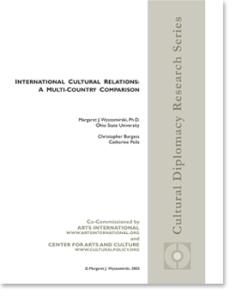
Author: Wyszomirski, Ph.D., Margaret J.; Burgess, Christoper; and Peila, Catherine
Publication Year: 2003
Media Type: Periodical (article)
Summary:
Diplomatic historian Frank Ninkovich observed that public diplomacy is “the promotion or communication between peoples as opposed to governments…” and is designed to “build agreement based on common values.” (Ninkovich, 1996, p. 3) As expressed in the motto of the former United States Information Agency, the aim of public and cultural diplomacy efforts is “telling America’s story to the world.” Public diplomacy is a two-way communication process that includes both efforts to project a nation’s image and values to other countries and peoples as well as to receive information and try to understand the culture, values and images of other countries and their peoples. Gifford Malone reinforced this point, saying “If we strive to be successful in our efforts to create understanding for our society and for our policies, we must first understand the motives, culture, history, and psychology of the people with whom we wish to communicate and certainly their language.” (Malone, 1988, p. 12) The continuity of these goals and philosophy can be seen more recently in the September 2000 Strategic Plan of the U.S Department of State.
Abstract:
Diplomatic historian Frank Ninkovich observed that public diplomacy is “the promotion or communication between peoples as opposed to governments…” and is designed to “build agreement based on common values.” (Ninkovich, 1996, p. 3) As expressed in the motto of the former United States Information Agency, the aim of public and cultural diplomacy efforts is “telling America’s story to the world.” Public diplomacy is a two-way communication process that includes both efforts to project a nation’s image and values to other countries and peoples as well as to receive information and try to understand the culture, values and images of other countries and their peoples. Gifford Malone reinforced this point, saying “If we strive to be successful in our efforts to create understanding for our society and for our policies, we must first understand the motives, culture, history, and psychology of the people with whom we wish to communicate and certainly their language.” (Malone, 1988, p. 12) The continuity of these goals and philosophy can be seen more recently in the September 2000 Strategic Plan of the U.S Department of State. [p. 4]
CONTENTS
- Overview, by Margaret J. Wyszomirski
- Background
- Notes on the Comparison
- Comparative Dimensions
- Terminology and Role
- Goals and Priorities
- Administrative Structure Comparative Funding Analysis
- Table 1 - Goals, Priorities and Administrative Structure: Cultural Diplomacy in Nine Countries
- Table 2 - Program and Funding Detail: A Nine Country Comparison
- Table 3 - Programs and Funding: Multi-Country Comparison (in US$)
- Table 4 - International Cultural Relations – Comparative Rank Orderings
- References
- Country References
- Country Profiles
- Australia
- Austria
- Canada
- France
- Japan
- Netherlands
- Singapore
- Sweden
- United Kingdom
Arts & Intersections:
Categories: International, Cultural Diplomacy and Exchange
ADDITIONAL BIBLIOGRAPHICAL INFORMATION
Series Title: Cultural Diplomacy Research Series
Edition:
URL:
SBN/ISSN:
Pages: 67
Resources: Document
PUBLISHER INFORMATION
Name: Center for Arts and Culture
Website URL: http://www.AmericansForTheArts.org